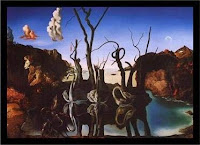TANNING AT THE TATE
REFLECTIONS ON SURREALISM
It is
difficult to believe but we will soon be approaching the hundredth birthday of
Surrealism, child of DADA and Freud, the most famous art movement of the 20th
Century. From advertising to comic books and movie posters surrealist images
are ubiquitous and ingrained into the culture. What precocious teenager did not
have an Athena Salvador Dali poster on their wall? For a taste for surrealism
was a short cut to showing that you were ‘deep’
and ‘arty.’
 |
| Iconic Dali Image |
It’s very success
was its greatest failure, when images adorn every Tube station platform or
magazine advert they cease to be original, let alone shocking. So, it was with
mixed feelings that I approached the Dorothea Tanning exhibition at the Tate.
 |
| Volkswagon Advertisement |
Given the
rampant sexism that even now characterises the art world, it is perhaps understandable,
if unforgivable, that I had only ever heard of Tanning as the wife of Max Ernst
so that her work was/is entirely new to me. The exhibition proved to be a
revelation, managing to be both original and genuinely disturbing. At its best
Surrealism has the capacity to challenge reality
unsettling and disturbing our settled views of the world. And Tanning’s work is Surrealism at its best.
Of course,
few questions feel as crass than “what is it about?’ Yet unless an image is not just a surprising, shocking
or merely interesting collage of strange and unexpected images, then there are passions,
ideas, desires, fears and anxieties behind the images. The Surrealist project is
one of tension and unease anything else is merely novelty. There is an uneasy
edge to Tanning’s work.
‘Tanning was
born in the small town of Galesburg Illinois where she said “nothing happened
but the wallpaper.”’ This was/is about as far away from the bohemian art world
of New York, Paris and Berlin as it is possible to get. Yet it is perhaps this
very upbringing that accounts for both her originality and her ability to imbue
everyday domesticity with menace and tension. If nothing happened but the wallpaper,
then in Tanning’s imagination it was wallpaper out of which burst babies and which
the demons that hid behind the sofa emerged to claim the room as their own.
 |
| Dorothea Tanning Black Day |
We now enter
the fraught territory of what the paintings are ‘about. ‘Here alas the artist now departs the room, for she has no
say now in what goes on between you and her art, for it is now you who create meaning, you decide what the painting or the sculpture is ‘about.’


